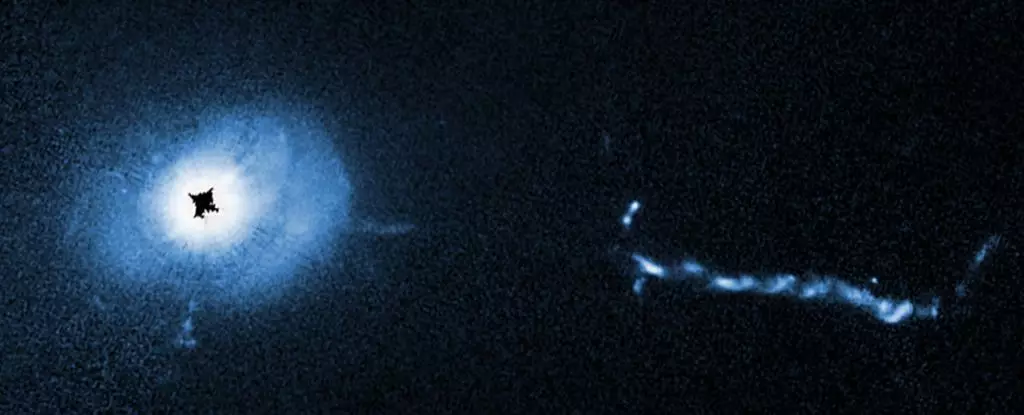In the expansive theater of the cosmos, quasars stand out as some of the most formidable players. Recently, astronomers utilized the iconic Hubble Space Telescope to delve deeper into one such celestial entity, known as 3C 273. Positioned approximately 2.5 billion light-years from our planet, 3C 273 is recognized not only for its remarkable luminosity but also as one of the closest quasars to Earth. The latest findings mark a significant advancement in our comprehension of the phenomena surrounding these extraordinary cosmic structures.
Traditionally, the study of quasars has been hindered by their great distance and immense brightness, which complicates our ability to discern detailed structures. However, the recent observations from Hubble have ushered in a new era of quasars analysis. By harnessing the capabilities of the Space Telescope Imaging System (STIS), researchers managed to employ a quasi-coronagraph technique. Imagine covering your eyes while attempting to spot objects illuminated by a powerful flashlight; this technique effectively diminished the overwhelming brilliance of the quasar, allowing scientists to observe the intricate details surrounding its core.
The latest observations of 3C 273 have been categorized as unprecedented, providing a wealth of data that offers a more nuanced perspective of its composition. These insights enable researchers to identify specific structures such as potential satellite galaxies or material clusters, showcasing a complex interplay of cosmic forces that remained elusive until now. This represents not just a step forward for the understanding of 3C 273, but also a validation of innovative observational techniques that could benefit future studies of other quasars.
At its core, a quasar like 3C 273 is thought to derive energy from a supermassive black hole, which lies at the center of its host galaxy. While black holes themselves emit no visible light, the accretion of gas and dust around them creates an extraordinary effect. The material spirals inward at extreme velocities, generating intense gravitational and frictional forces that elevate temperatures to staggering levels. This process results in the surrounding material radiating light—often across the entire electromagnetic spectrum—before ultimately succumbing to the gravitational grasp of the black hole.
What sets 3C 273 apart is its overwhelming brightness, outshining trillions of stars combined. Despite its distance of 2.5 billion light-years, it has the striking ability to be observed with relatively modest telescopes, providing an extraordinary window into the dynamics of quasars. The luminosity of 3C 273 serves as a beacon, illuminating complex cosmic interactions, illuminating structures otherwise obscured in the inky dark of space.
The Hubble observations revealed several fascinating features close to 3C 273’s core region, extending within a radius of 16,000 light-years. Among these features were small clumps that might represent either nascent satellite galaxies or debris poised to irrevocably merge with the quasar’s gravitational influence. Additionally, a newly documented core jet emanating from the black hole, along with an enigmatic L-shaped filament, intrigues astronomers, raising questions about their origins and purposes.
Significantly, researchers also gathered data about the astrophysical jet—a high-speed stream of particles ejected from the black hole’s magnetic field. Extending an extraordinary 300,000 light-years into intergalactic space, this jet exhibited curious behavior, demonstrating a trend of increasing velocity with distance from the black hole. Such findings offer tantalizing clues about the operational dynamics of quasars and the physical mechanisms governing their behavior.
The collected data from Hubble’s observations is not simply a triumph of technology; it represents a foundational step towards untangling the complexitiesof quasar dynamics, particularly the relationship between the central black hole and its surrounding structures. As astronomer Bin Ren highlighted, Hubble’s capabilities bridge the gap between detailed radio interferometry and broader optical imaging, enabling a comprehensive understanding of quasar morphology.
The newfound insights into 3C 273 will likely inform myriad future studies of quasars, which continue to be a dominant force in the universe’s evolution. By mining this data for further analyses, astronomers are poised to unlock additional mysteries about the nature of these celestial giants, potentially realizing a more profound understanding of galaxy formation and interactions, thereby revealing the intricate tapestry that constitutes our universe.


Leave a Reply